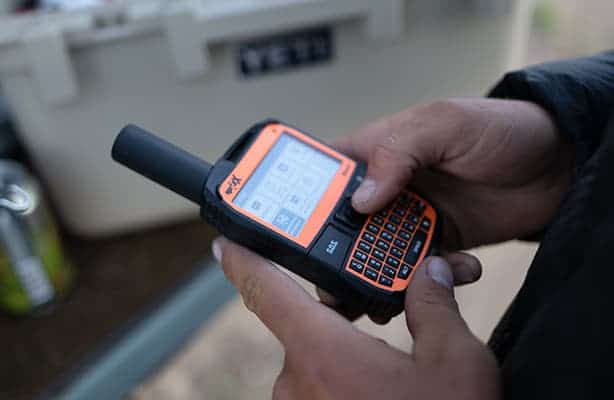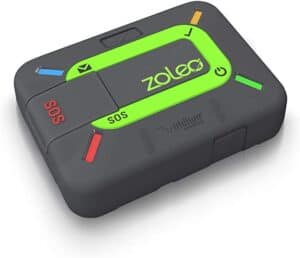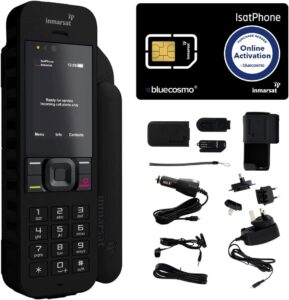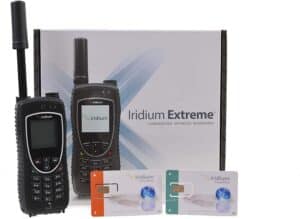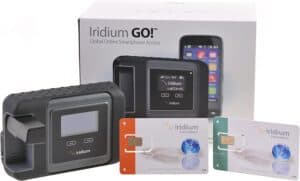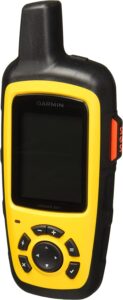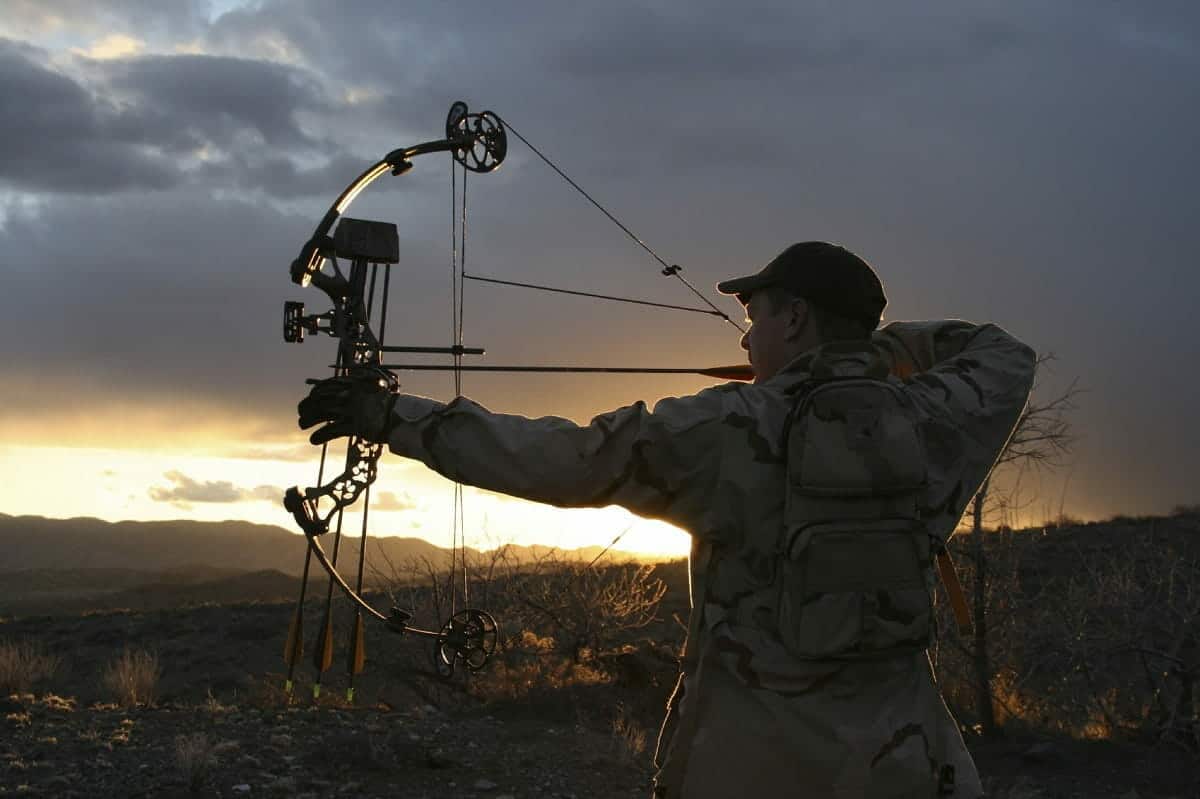A satellite phone is perhaps one of the best examples of a survival item that you want to have and not need, rather than the other way around. Ideally, everything goes as planned and you never touch your satellite phone for the duration of your trip. But if things go sideways, being able to make contact with the outside world can easily be the difference between what will just end up as a good campfire story and an experience that can turn tragic.
Good satellite phones on the market today will give you ample coverage in even the most remote wilderness areas. Whether you like to spend days or weeks out on a hunt, enjoy rafting through remote stretches of the Grand Canyon, or like to climb the world’s most rugged peaks, a satellite phone is a must-have survival item.
In this article, we’ll review the Top Ten Satellite Phones of 2023 and we will also offer some of the most important criteria to consider when selecting a satellite phone in our Buyer’s Guide. In conclusion, we hope that our Frequently Asked Questions section will answer any remaining concerns you might have so that you can purchase the best satellite phone for you.
1. Iridium 9555
The next version from Iridium Communications is the 9555 satellite phone. It’s a step below the 9575 Extreme, but it still boasts industrial-grade durability and a more compact physical footprint for streamlined portability. It’s designed to transport more easily, but still connects to Iridium’s reliable global network for superior connectivity when you need it most.
This is a great satellite phone for first-time users because it offers an intuitive user interface for better out-of-the-box functionality. It also comes with enhanced SMS and email messaging capability, as well as the options to use it with a headset or hands-free setup. The newest 9555 model includes an internally stowed antenna and an upgraded mini-USB data port.
2. SpotX 2-Way Satellite Messenger
The SpotX 2-Way Satellite Messenger is a great way to stay connected in the backcountry that won’t break the bank. With the option to text, check-in, track GPS, Alert Emergency Services, it covers all of the bases. It has the ability to exchanges messages with any cell phone number from virtually anywhere in the world. You can download the Spot App and use the Satellite features from your own phone.
The SpotX has the ability to track your movements in increments of 2,5,10,30, or 60 minutes. You can allow use the check in feature to let loved ones know that you are safe. In case of serious emergency you have the ability to communicate with Emergency Personnel about the nature of your emergency and get the assistance you need. So far SPOT has over 7,000 rescues and counting.
3. ZOLEO Satellite Communicator
The ZOLEO Satellite Messenger is a rugged and reliable device that enables communication in remote areas and beyond cellular coverage. It uses the Iridium satellite network to send and receive messages, share your location, and provide SOS alerts in case of an emergency.
The messenger comes with a free app that lets you compose and read messages on your smartphone, tablet, or computer. It also offers weather updates and check-in features to keep you connected with family, friends, and colleagues. The ZOLEO Satellite Messenger is compact, lightweight, and easy to use, making it an ideal companion for outdoor enthusiasts, adventurers, and professionals.
4. BlueCosmo Inmarsat IsatPhone 2.1
The Inmarsat IsatPhone 2.1 from BlueCosmo comes with a total of 192 Global Talk minutes and you also have the option to add another 250 pre-paid units that are valid for 180 days. This satellite phone doesn’t have any hidden fees or activation charges and you can easily purchase additional pre-paid units online when needed. The entire kit includes the phone handset, a lithium-ion battery, international AC wall charger with international plugs, automobile DC charger, holster with belt clip, hands-free earpiece, lanyard, USB cable, USB thumb drive, quick start guide, SIM card, and 18-month warranty.
This satellite phone offers global coverage with no roaming charges. It allows you to make and receive voice calls, send SMS messages, and track your GPS position anywhere on the planet, with the minor exception of the extreme north and south poles. The phone itself has an IK04 shock resistance rating and an ingress rating of IP65 (1), which means it can withstand dust, dirt, and jets of water from any direction. It also features a humidity tolerance up to 95% and an operational temperature range from -4 degrees to 131 degrees Fahrenheit (-20 to 55 degrees Celsius).
5. Iridium 9575 Extreme
By many standards, the Iridium 9575 Extreme is the most advanced satellite phone on the market today. It offers access to global coverage for voice, data, and SMS services. It is also the first satellite phone with fully integrated services of customizable GPS, online tracking, and emergency SOS button with notification services.
This satellite phone boasts military-grade durability (2) (MIL-STD 810F) and an ingress rating of IP65, which means it withstands water, dust, dirt, and other debris that it will encounter in the outdoors. It offers a battery standby time up to 30 hours and talk time up to four hours. It also features two-way SMS and short email capability. The keypad of the phone will light up for easy use in low light conditions and this phone has an operational temperature range of 14 to 131 degrees Fahrenheit (-10 to 55 degrees Celsius).
6. Iridium GO! 9560
The GO! 9560 Satellite Terminal comes with a Wi-Fi hot spot that allows up to five users to connect their mobile devices and use them where standard cellular networks are unavailable. The terminal’s integrated antenna simply needs to be flipped up and the battery-powered unit will connect to the Iridium Leo satellite Constellation to create a hotspot for Wi-Fi calling. Phones connected to the terminal will be able to be used within a 30.5-meter (100 foot) radius.
This satellite terminal supports global voice calls, as well as email access, applications, social networking, photo sharing, two-way SMS, GPS tracking, and built-in SOS button alert. It’s a great satellite terminal for wilderness expeditions that want the additional functionality of their smartphones in areas where they otherwise would be rendered useless. The unit is small enough to fit in your pocket and tough enough to withstand rain, sand, dust, and rough use.
7. Garmin inReach SE+ Handheld Satellite Communicator
The Garmin inReach SE+ is a GPS unit with 100% global Iridium satellite coverage. When you purchase a satellite subscription, this coverage enables two-way text messaging from anywhere and the unit also gives you the ability to use the SOS button and send it to the 24/7 search and rescue monitoring center. Being a GPS unit, this satellite communicator also allows you to track and share your GPS location with family and friends while you’re away.
This Garmin unit can be paired with mobile devices through the Earthmate app (3). This app gives you access to downloadable maps, U.S. NOAA (4) charts color aerial imagery, and more. The Earthmate app also allows you to use the inReach features on your paired mobile device. You can even sync your inReach communicator with your phone’s contact list for easier messaging with fewer keystrokes.
8. Garmin inReach Mini
This satellite phone is also from Garmin, but the inReach Mini is a smaller, rugged, more lightweight two-way satellite communicator. Like the inReach SE+, this unit gives you access to two-way text messaging using the 100% global Iridium network. You will have to purchase a satellite subscription separately to get the full functionality of this handheld GPS unit. The inReach Mini can also be paired with Garmin Pilot (5) to track your aircraft’s position and communicate it with your followers on the ground.
This unit is ideal for lightweight travelers that want to maintain off-grid connectivity without carrying a large satellite phone everywhere they go. It’s a palm-sized unit that offers all of the same features of the SE+, including the ability to send and receive text messages, track and share your journey with friends and family, and trigger an SOS alert to contact the GEOS (6) 24/7 emergency response team (only if absolutely necessary!).
—
Buyer’s Guide
Certain satellite phones are better for specific applications than others. Depending on your primary needs, you’ll want to find a satellite phone that fits them most closely. In this Buyer’s Guide, we’ll cover some of the essential criteria to keep in mind when sorting through these satellite phones.
Satellite Coverage
Satellite coverage can largely be broken down into three categories, regional, worldwide (with the exception of the poles), and global. Regional units will be best for those who are certain they will only be using the satellite phone within the unit’s coverage area. When considering these units, you should be careful to understand the exact region in which the phone will remain useful.
Most of the best satellite phones offer either global or worldwide coverage. Worldwide coverage excludes the extreme north and south poles but will remain useful across 90% of the planet’s surface. Truly global satellite phones are best for anyone that needs coverage across 100% of Earth, including oceans, airways, and poles.
Data Speeds
Most satellite phones are meant primarily for emergency voice calls, so they offer pretty middling data speeds. However, if you need to get some real work done in a remote region, such as sending a spreadsheet or receiving a critical text message, you’ll want to be sure that your satellite phone has enough data to make that possible.
Some of the regional satellite phones actually offer higher data speeds than the global models, just so that you’re aware. This is because those phones are generally used by those that have established outposts or basecamps in remote regions and need to have better data connectivity to communicate with outside entities in more developed areas.
Battery Life
The best battery life amongst satellite phones offers up to nine hours of talk time and up to 100 hours of standby battery life. It’s more common for phones to offer 30 to 40 hours of standby time and three to six hours of talk time. In the worse case scenarios, being able to stay on the phone with an emergency response team for more than three hours can really come in handy and help to reassure you in a wilderness setting.
However, if you’re not going to be using your satellite phone in extremely remote regions where help will typically be available within a matter of hours, it may not be necessary for you to spend the extra money on a model that offers almost 10 hours of talk time. Additionally, the purchase and proper maintenance of a spare battery can go a long way towards alleviating the need for a satellite phone with extremely extensive battery life.
Resistance to Environmental Conditions
Before you settle on a satellite phone, you should take some time to research ingress ratings and understand the operational temperature and humidity ranges of the unit. If you’re taking trips in equatorial regions, you’ll want a unit that can withstand very high humidity levels.
On the other hand, if you’re purchasing a phone for an Arctic expedition, you need to make sure it will work in sub-freezing temperatures. Because satellite phones are so often used for emergencies, you don’t want to choose one that only works when conditions are ideal. At a minimum, you should choose a phone that offers some resistance to shock, jet water, dust, and other debris.
Size
Once again, the type of expeditions you’ll be taking will largely dictate the size of the phone you want to bring with you. If you’ll be hauling in a bunch of gear, setting up a basecamp, and then carrying less on daily outings, it won’t matter if you choose a larger phone that offers the other features you’re looking for.
But if you’re a thru-hiker or otherwise involved in an expedition that has you moving on a daily basis, you might want a unit that doesn’t weigh your pack or sleds down. In this case, you’ll probably be looking for a phone that simply allows you to track your position and communicate with the outside world in the case of an emergency. Fortunately, you can find a phone that meets these two criteria in a relatively compact package.
Price
You can either choose to pay more up front for a satellite phone bundle that comes with everything you need to use it right out-of-the-box. Or you can opt to purchase a more affordable unit and then worry about paying for a satellite subscription, SIM card, and other essential items for connectivity separately. There are pros and cons to each approach.
The main advantage of purchasing a ready-to-use bundle is that you can take it out of the box, test it out, pack it up, and take it on your next trip without making any additional purchases. The disadvantage of this approach is the higher initial cost and the risk of purchasing some items (contained within the bundle) that you actually don’t have any use for.
The main advantage of the second approach is reducing the initial cost of your buy-in. If you have more time on your hands to figure out which SIM card or satellite subscription makes the most sense for your needs, this might be a better option. However, you can sometimes wind up paying more in the long run by purchasing everything separately, so it’s really important to do more research on satellite subscriptions, prepaid plans, and SIM card costs before you opt for this approach.
Frequently Asked Questions
Although we hope our Buyer’s Guide has done an extensive job preparing you to make the right purchase for your needs, we’d like to make sure we answer a few more questions that we haven’t yet touched on in this section.
How can I test my satellite phone to make sure it’s working properly?
It is highly recommended that you adequately test your satellite phone’s usability before an emergency strikes. You can test your phone, free of charge, by dialing 00-1-480-752-5105. You can also receive additional testing information at Test Your Satellite Phone (7).
How much does it cost to call from a satellite phone?
The costs of making a call from a satellite phone will vary depending on the network you’re using and who/where you’re trying to connect to. Generally, however, costs will range from about $0.60 to $1.50 per minute.
What are the optimal conditions for using a satellite phone?
Satellite phones require a clear line of sight to the sky so that they can make and receive phone calls. This means that they won’t work very well (or at all) indoors. When outdoors, you should also be careful to find a place free of tall building or stands of trees, as these things can also affect a phone’s ability to connect to the satellite network.
Which accessories should I get with my satellite phone?
The answer to this question largely depends on how exactly you plan to use your phone. Generally, however, a spare battery is an essential accessory you’ll want to have if you plan to spend extended periods in remote areas. If you’re going to be out for a really long time, you might also purchase a solar charger separately, which will help you recharge spare batteries when not in use.
Summary
As we mentioned earlier, a satellite phone is certainly an item that you want to have on your person when the need arises. Being able to extend your connectivity beyond the typical range of cell phones can really come in handy for those interested in spending a lot of time in the world’s most remote regions. We hope you’ve enjoyed this review of the best satellite phones of 2023 and we wish you the best of luck in purchasing the right satellite phone to take along on your next adventure!

